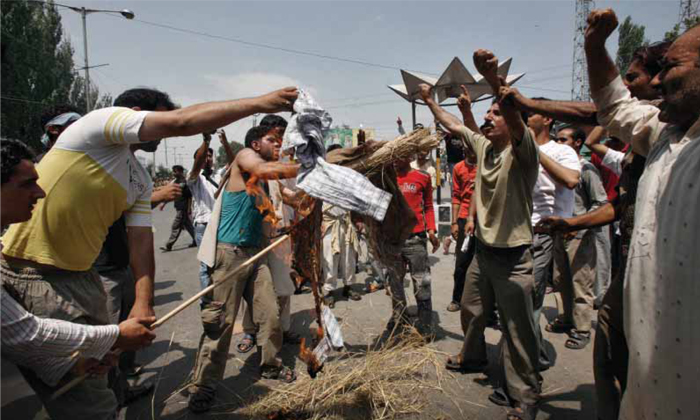When Vishwa Hindu Parishad president, Praveen Togadia visited Jammu on March 5, he obviously had no benevolent intentions. His credentials as a hatemonger and the fact that his name is in the chargesheet of the Malegaon blast case are public knowledge. So it is unclear why the government of Jammu and Kashmir, highly obsessed with issues of security and law and order, to the point of disallowing normal protests over development issues, did not think it important to stop him from proceeding to one of the most sensitive areas of the state – border town of Rajouri, which has a history of six decades of militarization and lies in close proximity with the volatile Line of Control that divides India administered Jammu & Kashmir from the Pakistan one. Rajouri is also sensitive for its fragile demographic equations, with the district having 60 % Muslims but the town having more Hindus. Rajouri’s special case should have inspired greater caution.
“Togadia’s visit coincided with the preparations for Holi which is celebrated with traditional processions. A day after his hate speech, tempers among the Muslims of Rajouri were high and they were demanding a case against Togadia, which was finally reluctantly registered.”
But the government’s security network literally escorted Togadia to this sensitive town. There is no other way he could have sneaked into a militarised zone like Rajouri, via the heavily barricaded winding narrow mountain roads. He freely poured his communal venom, and zoomed back an elated man, without anyone even questioning him. While the government did not do what was expected of it in a situation like this, nor follow it up with cautious steps and some reality checks, Togadia’s dynamite did what it was expected to – turning Rajouri into a ticking time bomb, neglected by a complacent or complicit administration, whatever the case was.
Togadia’s visit coincided with the preparations for Holi which is celebrated with traditional processions. A day after his hate speech, tempers among the Muslims of Rajouri were high and they were demanding a case against Togadia, which was finally reluctantly registered. But the administration did not deem it fit to take both the communities on board as the Hindus braced up for the festive procession. When the procession entered Muslim majority areas, some youth pelted stones which led to clashes between both sides with the police also getting involved. Only after the situation had deteriorated that a slumbering administration decided to impose curfew. One only heard feeble echoes of the boiling situation in the state legislative assembly in session in the winter capital at Jammu, just four hours from Rajouri. The government slipped into deeper slumber as curfew continued in Rajouri, was lifted for a day and re-clamped after the situation deteriorated.
On March 15, saffron activists from Jammu reached town, despite the curfew and began assembling for a protest rally. When the police and CRPF failed to contain them, they used brute force, not only dispersing protestors with batons, tear gas and firing in air but also entering houses and beating several locals and damaging their property. The situation was ideal for the saffron brigade to use for spreading the fire. The BJP, VHP and other saffron groups called for a Jammu bandh on March 17, doubling it up with circulation of baseless rumours. Finally they had to call off the bandh by noon when Hindus and Muslims of Rajouri sat together with a visiting group of ministers to sort out their differences.
Had it not been for the efforts of community leaders from both sides in Rajouri, the story may have turned out differently. The initiative was taken by the Muslims of Rajouri, who visited the Hindu majority areas on March 16 to express concern over brutal police action a day earlier. The team of ministers that facilitated the meeting between the two groups also helped resolve the crisis. Transfers of the Superintendent Police and District Deputy Commissioner helped cool down tempers, as did assurances of releasing the youth picked up by the police.
The issue, however, cannot be deemed settled, by simply rolling some heads, with punishment amounting to simple transfers at best. There needs to be a far more extensive probe as to why Togadia was escorted with full security in and out of Rajouri, allowed to get away after making his provocative hate speech and why the local administration failed to pre-empt the consequences and get its act together before the religious procession was stoned at. It wouldn’t have been unusual for the government to deport Togadia or stop the festive procession, or even change its route. Last year, when the BJP began its ill-conceived drama of hoisting the tricolour at Srinagar’s Lal Chowk, the government, sensing trouble, did turn them back from Lakhanpur at Jammu-Punjab borders. For two years, the separatist leaders have been detained in prisons or put under house arrest in the name of law and order, even though there has been no evidence of their link with the stone pelting mobs of the Valley. Human rights activists Gautam Navlakha and Sehba Hussain were deported from Srinagar airport last summer, even though both of them are known for their secular credentials and peace making efforts across the sub-continent. At around the same time, Chief Minister Omar Abdullah threatened to ban Ram Jethmalani from heading the Kashmir Committee for equating the Valley to a Nazi camp. Then why was Togadia sent with full state escort to Rajouri?
It is also be important to question why, despite the curfew, saffron activists managed to reach the troubled town to create a more lethal recipe for disaster, followed by the brutal and unjustified action of the police and CRPF in dealing with the mob. The mishandling of the situation was reminiscent of the 2008 Amarnath land row that lasted for three months, exacerbating regional and communal divides in Jammu and Kashmir like never before. That time, the government consciously fanned the Hindutva fire to counter Kashmir’s voice for ‘azadi’. There is a need to know, whether there was a deliberate design in sending Togadia and thereafter shunning all responsibility.
At the same time, it is important to celebrate the role of the two communities in trying to resolve the issue amicably; demonstrating once again that it is community level efforts that can best deal with communal polarisation, provided, of course, the government is pragmatic enough to play the role of facilitator rather than being agent provocateur. Without their pro-active involvement, this crisis could not have been tided over. Such gestures of speaking out for the ‘other community’ are rare but this small border town has set an example for the people of the rest of the state to emulate. There’s also a lesson for the government here: that it needs to provide a space for such voices of harmony rather than suppressing them, as is often the case, and also ensure that troublemakers from outside are kept off the confines of the state, and those within are contained and not let loose for petty political benefits.
Related


